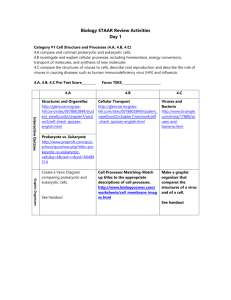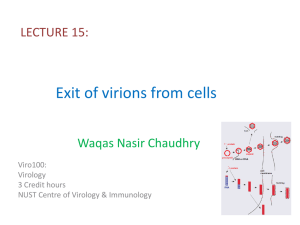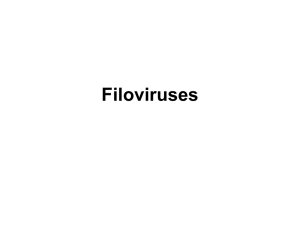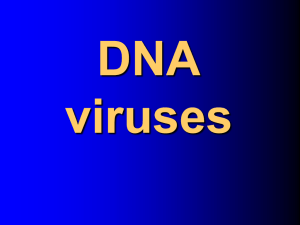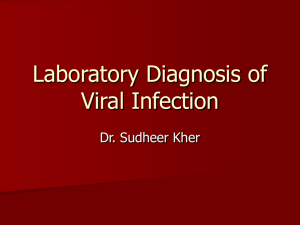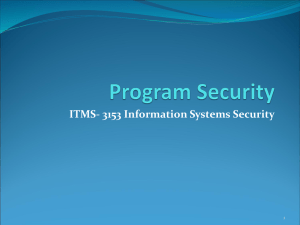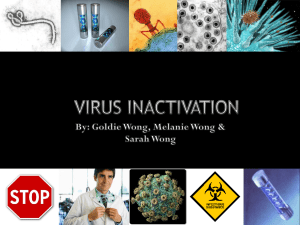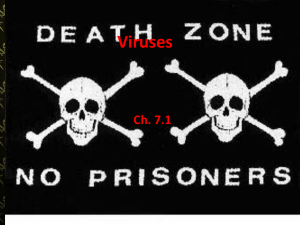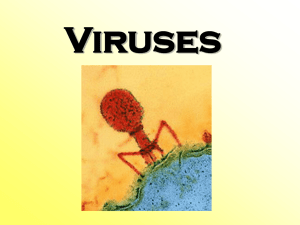Introduction to Microbial Pathogenesis
advertisement
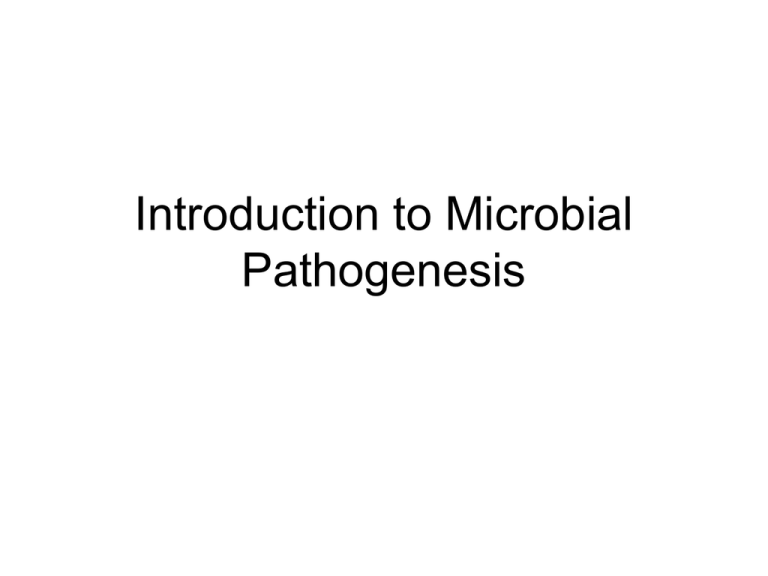
Introduction to Microbial Pathogenesis Infectious Agent (Proposed by Henle in 1840; demonstrated by Koch in 1876) • “a single [type] of micro-organism could be isolated from all animals suffering from anthrax; • the disease could be reproduced in an experimental host by infection with a pure culture of this bacterium; and • the same [type] of micro-organism could subsequently be reisolated from the experimental host.” Infectious Agents in Humans • • • • • • Prion - scrapie Viruses – HIV, influenza Bacteria – Mycobacterium tuberculosis Fungi – Candida albicans Protozoa – Plasmodium falciparum Helminths – Schistosoma mansoni Prion normal abnormal Virus Bacteria Fungi Protozoa Helminths Ascaris lumbricoides : human intestinal roundworm Barriers Physical barrier: Skin, Mucosal gel overlaying epithelium (respiratory, gastrointestinal, urogenitary) Microbiological barrier: Normal microbioflora Initiation of Disease Initiation of Disease contact with pathogenic organism: human to human, animal to human Transmission • Aerosols to respiratory mucosa • Fomite to nasopharyngial or conjungtive mucosa • Fecal – Oral Route • Mucosal surface to mucosal surface Infectious Disease Cycle Transmission Dissemination Breach of epithelium or Colonization of mucosa Evasion of host defense Multiplication Attachment to target cells Invasion to subepithelial or intracellular space Adherence/Attachment Specific Adherence • Receptor-mediated adhesion Non-specific Adherence • Hydrophobic/lipophilic- mediated adhesion •Hydrophobic struture on microbial cell envelope •Lipophilic area on host cell membrane Specific Adherence Microbial adhesin Host cell receptor Bacterial Fimbrial Uropahogenic E coli P-pili Afimbrial Staphylococcus aureus fibronectin binding protein Herpes simplex 1 virus glycoproteins B, C and D Viral Measles virus hemagglutinin (H) protein Epithelial cell glycolipid receptor globobiose Epithelial, endothelial, fibroblastic cells fibronectin receptor integrin Epithelial cells of skin and mucosa heparin sulfate Epithelial, endothelial cells, mononcytesmacrophages (and others) CD46 Invasion bacterial •Transcytosis across superficial epithelium to subepithilial space •Induce engulfment by nonphagocytic host cells •Local reararrangement of host cell cytoskeleton viral •Pass through plasma membrane •Membrane invagination •Clathrin •Fusion with host cell plasma membrane •Phagocytosis •HIV gp120/41 •Utilization of membranous cell gateway •T lymphocyte CD4 •Macrophage CCR5 Evasion/Manipulation of Host Defense • Modulation of innate/inflammatory response • Resistance to phagocytic killing in subepithelial space • Serum resistance • Antigenic variation Modulation of Innate/Inflammatory Response Adhesin-directed degranulation of mast cells histamine cytokines degranulation mast cell E. coli bound to mouse mast cell proteoglycans Resistance to phagocytic killing in subepithelial space • Inhibit phagocyte mobilization :(chemotaxis, complement activation) Inhibit chemoattractants: Streptococcus pyogenes degrades C5a Inhibit chemotaxis: Pertussis toxin causes intracellular rise in cAMP in neutrophils to impair chemotaxis • Avoid ingestion kill phagocytes: Streptolysin O lyses PMNs; Staphylococcus aureus alpha, beta and gamma toxins and leucocidin lyses PMNs capsular protection from opsonization: M proteins, Streptococcus pyogenes Bacterial capsules that resemble self: Neisseria meningitidis (sialic acid); Streptococcus pyogenes (hyaluronic acid) • Survive within phagocyte Survival within phagocyte Escape endosome or phagolysosome: - Shigella, Listeria monocytogenes Inhibit phagosome-lysosome fusion - Legionella pneumophila, Mycobacterium tuberculosis, Salmonella Survive within phagolysosome (resist enzymatic degration or neutralize toxic products) - Inactivate reactive oxygen species: Salmonella, via superoxide dismutase, catalase, recA - Resist antimicrobial peptides: Host cationic peptides complexed with SapA peptide covalent binding of activated sialic acid LPS galactose residue changes to carbohydrate portion of lipooligosaccharide complement resistance Serum Resistance intracellular lifestyle prevent insertion of C9 complex into outer membrane N. gonorrhoeae long O-side chains of LPS outer membrane protein Rck Salmonella inhibit deposition of C3 incorporate host plasma proteins (decay accelerating factors) into membrane Schistosoma mansoni prevent C3 convertase formation sialic acid in LPS O antigen hydrolyzing enzymes inhabit blood cells to avoid exposure to humoral factors (e.g.complement) PMN cells lymphocytes macrophages red blood cells Staphylococci HIV Mt Plasmodiumium Antigenic variation Phase variation Genetic variation Transmission of genetic information via mobile genetic elements Gene recombination VSG in Trypanosoma brucei - Pili genes: Neisseria gonorrhoeae Gene reassortment - Influenza viruses A, B, C High mutation rate - RNA virus: Influenza viruses A, B, C Recombination of replication products - DNA virus: terminal redundancy in linear genome Cell and Tissue Damage • Induction of apoptosis and necrosis • Virus-induced cytopathic effect • Induction of damaging host immune response Induction of apoptosis Phase variation Genetic variation Transmission of genetic information via mobile genetic elements Gene recombination VSG in Trypanosoma brucei - Pili genes: Neisseria gonorrhoeae Gene reassortment - Influenza viruses A, B, C High mutation rate - RNA virus: Influenza viruses A, B, C Recombination of replication products - DNA virus: terminal redundancy in linear genome Induction of Cell Death Induction of apoptosis Induction of necrosis Virus-induced apoptosis: HIV (CD4+ T cell), EBV, adenoviris Bacterial toxins: Interfere with cellular regulation of cAMP Diptheria A-B toxin -Bordetella pertussis (macrophage) Activation of caspase-1 Salmonella (macrophages, DC) SipB binds and activates caspase-1 Sigella flexneri (macrophages) Invasion Plasmid antigen B (IpaB) binds and activates host caspase-1 Virus-Induced Cytopathic Effect: Part 1 accumulation of reactive oxygen intermediates Cell lysis accumulation of nitrogen intermediates accumulation of intracellular calcium Syncytia formation macrophages viruses Rotavirus, cytomegalovirus, HIV Paramyxoviruses (respiratory syncytial virus, parainfluenza viruses, measels virus, herpesvirus, some retroviruses) viral-encoded fusion proteins Virus-Induced Cytopathic Effect: Part 2 production of eosinophilic or basophilic inclusion bodies viruses Burkitt's lymphoma (EBV) host cell transformation inactivation of p53 and Rb, chromosomal destabilization, enhancement of foreign DNA integration and mutagenecity DNA viruses retroviruses cervical carcinoma (human papilloma viruses) adult T-cell leukemia (human T-cell lymphotropic virus type 1) Induction of Damaging Host Immune Response cross-reactivity between self and mycobacterial heat shock proteins autoimmune response cross-reactivity between components of endocardium and joint synovial membrane molecules and antigens in the streptococcus cell wall Acute rheumatic fever after group A streptococcal pharyngitis hypersensitivity reactions granuloma formation septic shock/sepsis toxic shock Mycobacterium tuberculosis bacteria LPS, peptidoglycan, lipoteichoic acid, toxins acting as superantigens

